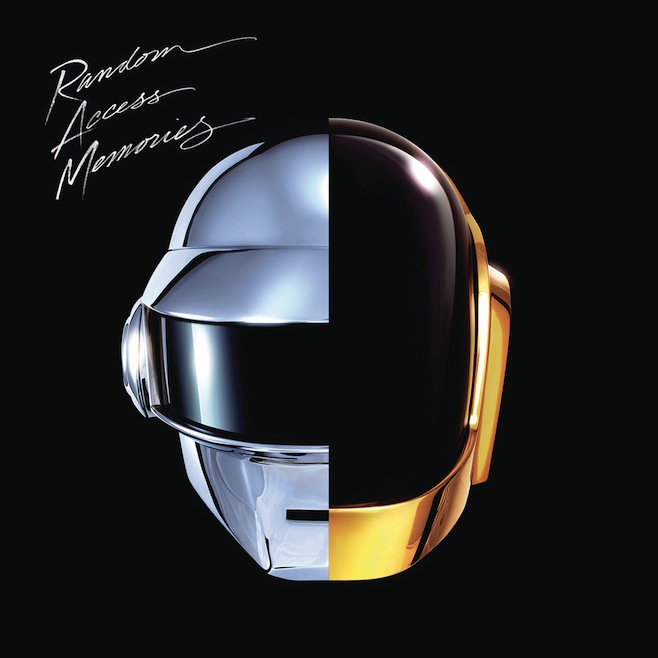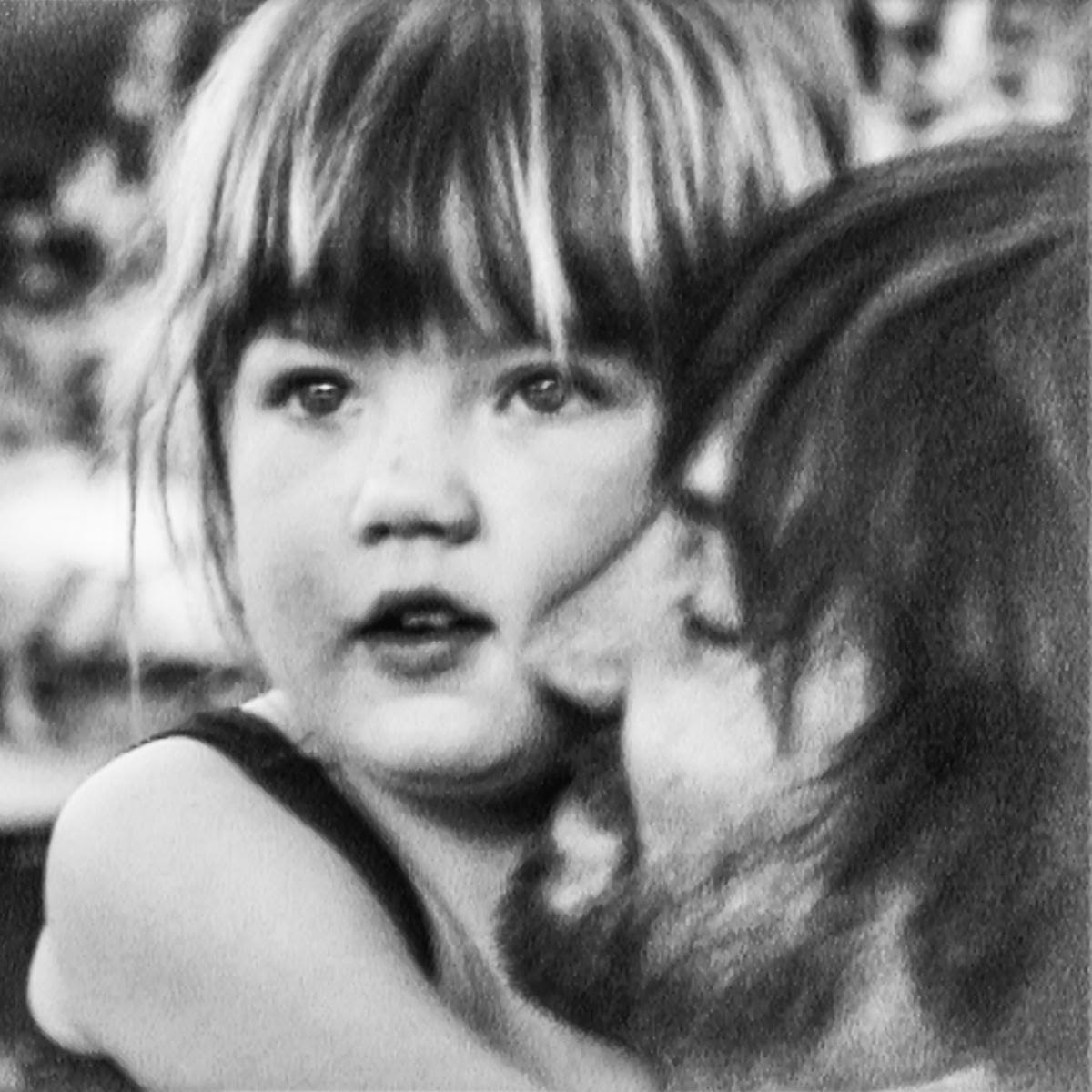Daft Punk's new album Random Access Memories is a lot of things: A masterful years-in-the-making publicity campaign set to music, a showcase of hellaciously expensive decades-old studio craftsmanship, a stunt-casted absurdist music event on the level of the Coachella Tupac hologram, a fascinating example of what happens when pop-star robots go to disco fantasy camp, a reminder that it's bee too long since you played Off The Wall front-to-back, an example of a hype-wave so deafening that you can almost forget there's an album behind it. But more than anything, it's a deeply silly piece of work. It's the guy who wrote "The Rainbow Connection" wailing that he needs something more over Styx pianos while a vocodered children's choir answers back that love is the answer. It's Pharrell crooning about how trying to get laid is like "the legend of the phoenix." It's Giorgio Moroder lecturing about click-tracks over a click-track. It's Julian Casablancas's gorgeously ragged voice processed beyond all recognition, or a Panda Bear solo song showing up in the middle of a bajillion-dollar dance-pop album for absolutely no reason. It's "Fragments Of Time," a far-balder Steely Dan rip than anything on that last Destroyer album. The whole thing is, in its own way, as mercurial a prank as anything Bonnie "Prince" Billy or Ween ever did, and maybe the most amazing thing about the great press rollout has been how little the actual people in Daft Punk have let on that they realize how goofy all this is. But like the best mercurial pranks, the album is also, in its own way, entirely serious.
Everyone else has already commented on it, but you have to admire the moxie here: The two steely-visored self-made icons who have become the shining metallic face of dance music taking a look at the monster they helped to create, then going a radically different direction. In interviews, the two humans in Daft Punk have alleged that they don't listen to dance music, that they'd originally thought that "EDM" was an actual DJ's name. But listening to the album, I don't believe a word of it; these guys have definitely heard enough chintzy Vegas-superclub buildup-breakdown music to absolutely detest it, even if their own minimal thump (and unprecedented faceless stardom) helped that stuff ascend to the point where it's utterly taken over top-40 radio. So they went into the lab for years, threw their laptops away, and recruited the expensive studio-pop session-musician legends behind disco, the last thumping dance music to take over American airwaves and drive people nuts. Daft Punk and the talking-head supporters being quoted in every magazine profile clearly want Random Access Memories to be a game-changer, a corrective to a popular wave that's grown too bloated for its own good. I don't think that'll happen; game-changing albums rarely come from the top down, from people who have diagnosed problems and strategized on how to fix them. They come from the margins, from people putting together things that they like and then throwing those things out there, like Daft Punk themselves did on Discovery. But in the breadth of its vision, and in the rigorous no-expense-spared attention to detail that went into realizing that vision, Random Access Memories is a pretty breathtaking album.
I've already seen a few critics crying rockism, and anytime musicians start extolling the virtues of "real" musicianship over its computerized simulation, that's a fair charge, even when the musicians in question pretend to be computerized simulations themselves. But when you're reviving some of the most marginalized, disrespected genres in history, I'm not sure the rockism charge can possibly stick. Random Access Memories isn't just a disco album; it's also a soft rock album, a smooth-jazz album, an album of planetarium-soundtrack music, a cheesed-out '70s Broadway version of a rock album. My coworker Claire Lobenfeld has already likened it to cruise ship music, but at least it's not one of those cruise ships where everything has broken down and there's shit everywhere. It's a gleaming, flawless machine, every guitar-squelch and drum thwack and robotic whoa rendered in extreme hi-fidelity. And the hard, dedicated work that went into making something this grand is, in its own way, kind of moving, the same way it's kind of moving to watch the credits of Iron Man 3 and look at the names of the armies of computer programmers necessary to make a movie like that happen. And heard in the right context, staring out your window while the sunlight hits a tree in a particular way, the silliest moment on this deeply silly album -- I'm thinking in particular of the children's choir on "Touch," though you probably have your own pick by now -- can be almost heart-stoppingly gorgeous.
I want to talk for a minute about "Giorgio By Moroder." When I first read that Daft Punk were working with the Italo-disco genius, one of my favorite musicians of all time, I got excited. When I read that Moroder would just be talking on the song, I was utterly flummoxed: This guy is one of the great time-rearranging producers of all time, but he never even sang on his records, and you're making him just talk? The first time I heard it, As Moroder's voice first chimed in, with the outside-restaurant background noise behind him, I rolled my eyes. But then it got to the "everybody calls me Giorgio" part, the pause, the brief window of time before one of those spine-chilling Moroder sequencer-burbles kicked in, and my brain just sort of flooded with endorphins and I forget what happened. But after that, the song keeps going on, and on, the different studio-session killers taking turns soloing in their own indulgently jazzy ways. And even though they're Kubrickian controlling-auteur types, I picture the Daft Punk robots just sitting back in the studio at this point, just kicking their own organic machine into motion and watching it work. That's not what happens, of course. What happens is that it builds and builds, leaving behind the department-store muzak and transforming into an intense prog-rave opus, like Goblin paying Justice back for the "Phantom Pt. 2" sample by outdoing Justice at their own game. At first, I wondered how many times I could listen to Moroder explaining his sleeping-in-his car days before I got sick of it. Now, I have trouble listening to anything else.
The rest of the album works like that, too, its hidden treasures already revealing themselves after less than 48 hours. "Instant Crush" and "Beyond" sounded like trifles at first, breaks between the peak moments, but after a few listens I'm already passionately singing along. "Lose Yourself To Dance" sounded clumsy and thin, but it caught me off-guard when I was cleaning my house last night, its deft syncopation, so different from the whump-whump-whump that we've accustomed ourselves to, suddenly convincing me that I'm a much better dancer than I actually is. And "Fragments Of Time," the aforementioned Steely Dan joint, hasn't snuck up on me that way yet, and maybe it will always sound plasticy and chintzy to me. But now, it seems a whole lot more likely that it'll sneak up and grab me by the neck at some point in the very near future. Daft Punk songs have a way of doing that. And sure, Random Access Memories is an album about music, an act of curation-as-art more concerned with making a statement about the way we make jams now than in cranking out some immediate summer jams that we'll all enjoy. It suffers for that, a bit. But the jams are there, and they reveal themselves more every time I hear the album. Maybe it's not the album that we wanted from Daft Punk. But it's sure as hell the album that Daft Punk wanted from Daft Punk. And heard in its own terms, that's a pretty marvelous thing.
Random Access Memories is out 5/21 on Columbia. Stream it at iTunes.
[videoembed size="full_width" alignment="center"][/videoembed]






